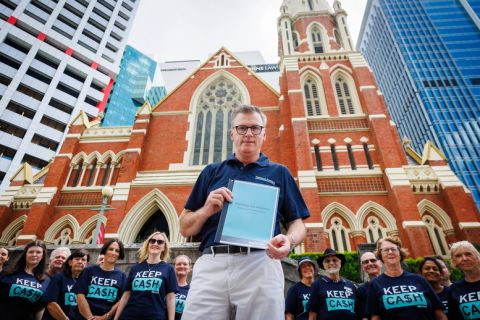Weather, insurance, and cost of living – it’s the perfect storm
We’re warned property insurance premiums will continue to rise because of extreme weather.

Storm scam warning
Householders and businesses are warned to be wary of ‘disaster chasers’ who offer quick-fix cleanup, repairs, and inspections, often demanding upfront cash payments for shoddy or incomplete work.
Some disaster chasers pressure homeowners to sign a contract on the spot for future repair work and may promise their insurer will pay. This can leave the homeowner liable to pay a commission or inflated repair bills not covered by their insurance policy, as insurers will only pay for approved work that is covered by a policy.
Residents who believe they may have been approached by or signed with a disaster chaser should seek guidance from their insurer.
Tips for identifying and dealing with a disaster chaser:
- An insurer will not send a tradesperson or builder to your home without notifying you and providing you with details.
- Speak to your insurer before agreeing to any repairs or rebuilding work to make sure your insurer will cover the work.
- A tradesperson or builder who is working for your insurer will not ask you for payment.
- If in doubt, ask for identification such as a builder’s licence or driver’s licence, and ring your insurer to check.
- If you sign a contract with a disaster chaser, you have a statutory 10-day cooling-off period. Your insurer can help you end the relationship with the disaster chaser.
The cost of house and contents insurance has increased significantly, with the national average annual premium rising by about $343 (14%) in the last 12 months.
Some regions have seen even larger increases, with the Northern Territory experiencing an average annual jump of $700 (17%).
And while the cost of repairs and materials and government taxes are major cost hike drivers, insurers are now warning that the regularity of extreme weather events will increasingly cause higher premiums.
Insurer, IAG has released its Severe Weather in a Changing Climate report, developed in partnership with the U.S. National Science Foundation’s National Center for Atmospheric Research.
The report, citing over 360 scientific publications, shows climate change is impacting the severity, frequency, and geographical distribution of weather events, and that the risk to Australian communities is increasing, with many natural hazards worsening in a warming climate.
Key report findings include:
- Short-duration intense rainfall and associated flash flooding, as well as fire weather risks, are of particular concern as they are escalating at a very fast pace.
- Large-to-giant hailstone risks are increasing at the fastest pace over the most populated regions, notably the Brisbane-Sydney-Melbourne corridor of Australia, while northern regions have declining risks.
- Tropical cyclone risks are rising most in southeast QLD, northern NSW and southwest WA, with potential for more intense tropical cyclones even though frequencies are likely to slowly decline.
IAG’s chief financial officer, William McDonnell said the insurance group, which includes the NRMA Insurance and CGU brands, found natural events were becoming more intense, at both ends of the weather spectrum.
"We can see that storms accelerate faster, " he said. "Strangely, things are getting both wetter and drier, so we expect the droughts are worse. There are fewer mild rainy days, but there are going to be more intense downpours."
The report found bushfire weather risks were escalating as climate change drives hotter, drier and more fire-prone conditions, faster than climate models predicted.
"Rising temperatures are leading to more days with extreme weather conditions conducive to uncontrollable bushfires, while shifting rainfall patterns are reducing soil and fuel moisture in some areas, creating continuous, fire-supportive landscapes," the report said.
"The frequency of heatwaves combined with dry conditions is expected to rise, significantly increasing the number of extreme fire weather days and, as a result, the intensity of bushfires."
Access the full report here.
Depending on the state or territory, government taxes and charges can add 20 to 40 per cent to the cost of a premium, according to the Insurance Council of Australia.
The council says as these taxes are levied in proportion to the cost of the premium, they penalise those who pay higher insurance premiums because of the greater extreme weather risk they face.
The council describes the taxes as “unfair and inefficient” and wants them abolished, which would it says improve insurance affordability, strengthen community resilience, reduce reliance on government relief in the aftermath of disaster, and ensure Australians are better protected in the face of increasing risks.
Importantly, reforming the taxes would provide cost of living relief, which the council says is a growing reason people are under-insuring their property in order to save money.
In 2020 the council found 83% of households believed they were underinsured.
Chief executive Andrew Hall advises people to take into account inflation and not "set and forget" the level of cover.
"The cost of rebuilding and repairing homes in the last three years has risen by 40% alone," he said.
"It's critically important when you think about your home and what you are insuring, that you think about the cost of actually repairing and rebuilding it."
Related Reading: Insurance Council, IAG
*The discount applies to the total National Seniors travel insurance premium and is for National Seniors Australia members only. Discounts do not apply to the rate of GST and stamp duty or any changes you make to the policy. nib has the discretion to withdraw or amend this discount offer at any time. This discount cannot be used in conjunction with any other promotional offer or discount
National Seniors Australia Ltd ABN 89 050 523 003, AR 282736 is an authorised representative of nib Travel Services (Australia) Pty Ltd (nib), ABN 81 115 932 173, AFSL 308461 and act as nib's agent and not as your agent. This is general advice only. Before you buy, you should consider your needs, the Product Disclosure Statement (PDS), Financial Services Guide (FSG) and Target Market Determination (TMD) available from us. This insurance is underwritten by Pacific International Insurance Pty Ltd, ABN 83 169 311 193.














